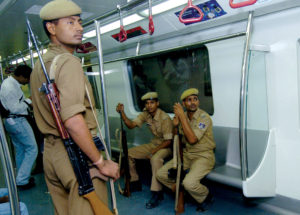Recurring eviction drives in Gurugram’s famed Banjara Market have left the Gadiya Lohar community, who started this market, in constant search of a new home and stability for their future
Situated in Gurugram’s sector 56 is the famous Banjara Market—a haven for all those who like to shop for furniture and home décor—run by the people of the Gadiya Lohar Community. People of this nomadic tribe migrated from Chittorgarh, Rajasthan to Gurugram, Haryana in the mid 2000s, and have been working and selling wooden, brass, ceramic as well as mirror-based goods and products in order to be self-sufficient, and to earn their livelihood ever since .
True to their name, ancestors of these Gadiya Lohars used to work as iron workers and artisans, however, their profession slowly faded away as it couldn’t fetch enough money, says Sahiba, a seller at the Banjara Market. Living in the vicinity and selling accents and wall hangings for almost 20 years, she shares, “When we came here for the first time, this land had nothing but jungles and life was full of problems as robbery, theft, killings, damages were everyday events. Slowly, other members of our community joined in and we started living together on this land.”
Determined to earn, live and eat peacefully, those living in the makeshift, roadside tents, shops and shanties, face constant fear of being evicted from the land they’ve been living on.
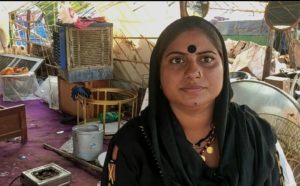
“The moment everyone settles in and things are going fine, the government suddenly asks us to go away and leave the place. We’ve built this market on the sole basis of our efforts and hard work, but they want to remove us from here as they think we have ‘occupied’ the land. What do we do? Where do we go now?” she questions. For sellers like Sahiba, the notion of “what a home is” has been rather conflicting as there’s no place they could call home or feel like home at.
The demolition
In October 2021, more than half of the establishments of this market spread across 8.5 acres were brought down and run over by a JCB. The local committee and police personnel along with the officials of the Haryana Shehri Vikas Pradhikaran (the urban planning agency of Haryana) demolished the huts and shops, following which many lost the roofs over their heads while others suffered financial loss.
Anita, living in the Banjara Market since 15 years, spends most of her time and days idle as she lost her home as well as shop in this destruction. She says, “Whenever demolition happens, the market is flooded with tractors and men. People come and break things worth 10-20 lakhs, of multiple sellers in the market. The biggest problems we face at times like these is the protection of our products. Where and how do we go with so many goods?”
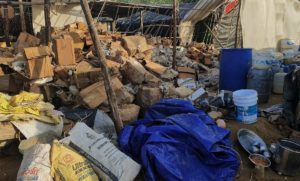
Just like others, Anita and her family consisting of two aging parents, a husband and a teenage daughter spent almost Rs 40,000 – 50,000 to rebuild their shanty. Their television, fridge, bed, machine and other household items were destroyed in the process of demolition too. “We’ve spent a lot on the reconstruction and still there’s no guarantee of us continuing to live here for the months to come. Sometimes the committee comes to remove and demolish everything twice a year, sometimes thrice, and sometimes they come and break us down every month. Nothing is fixed or certain here,” she sighs.
Sellers claim that they didn’t receive any official notice of the demolition and that talks of them being removed from the land were a daily affair. According to Sahiba, “Some people came 2-3 days before the demolition and asked us to vacate the land. We had bought a lot of stuff for the festive season and we couldn’t empty the space in time. We asked for some time but they said that we are encroachers and we want to occupy the land permanently. So, they came to break and bring everything down and then left.”
Homelessness–a constant virtue of their lives
Reena, a ceramic and serve-ware seller, is just as hit and saddened by the uncertainty and fear of not knowing where to go. She says, “We live in the constant fear of being removed from this place. We feel bad because there’s no place of our own or no home of our own. Deep down we are scared of what might happen in future, how we will live and earn.”
From Chittorgrah to Gurugram, these sellers have been going around and roaming on the streets with no one fixed spot. Living in fear of being evicted and broken down, Anita expresses, “First we were asked to leave Chittorgarh and now this market. It’s a cyclic process: they come, break our huts and then we rebuild again, and the same thing happens over and over.” While she is done with most of her life, Anita fears the kind of life her child and the upcoming generations would lead.
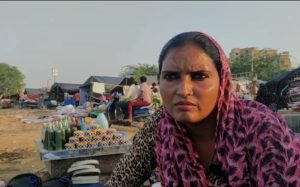
“We have small children and we live in such bad conditions. Our house is very small and it’s a makeshift place.” Sahiba continues, “They shatter that too and bring us on the pavements. We could never build a permanent home, nor will we ever do so.”
Problems faced by the sellers
“We live in a very ‘hand-to-mouth’ situation and we just spend and eat out of whatever we earn in the day. If we were earning more or had savings, we wouldn’t have been living this way,” says Sahiba who wants to educate her child and build a house, or at least find a decent place to live in. The lack of a permanent location or a place to stay puts a lot of things at stake. She continues, “We want to do something for our children so that they lead a good life and don’t end up like us. Because we are asked to relocate and shift too often and abruptly, their academics gets stuck and affected midway, and our children continue to remain illiterate. Without education, our and our children’s lives have become miserable.”
These Gadiya Lohars lead a life sans comfort and ease and have no separate space to use as a bathroom or bedroom. For the women living here, it gets worse as there’s no privacy or maintenance of hygiene. “Neither do they build any schools for our kids nor do they provide us a place to live in. Schools and washrooms are the basic necessities that are lacking here,” states Anita. She also highlights how during the monsoons, their shanties get filled with water and the men from the committees or the police offer no help or aid. “Rather they stand and give orders to break our shops, homes and huts. All our goods and products also get damaged and destroyed in the process,” Anita emphasizes.
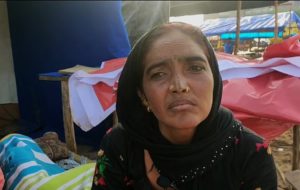
Those without a home suffer a lot. Without education, getting a job and earning is tough. Sahiba reinstates that there’s no roof over their heads, no washrooms, and no clean water supply. They have nothing and their children continue to grow and live like this. “Even then the government is doing nothing to help us and they have no sympathy for us,” she says.
Backbone of the community
While this flea market is very aesthetic and beautiful, and a perfect spot for shoppers, it enables the sellers to fill their stomachs, take care of their children and earn their livelihood. Reena shares that the sellers here take loans to buy goods and then sell the products to repay the loans and their debts. “This is how we operate”.
Sahiba has a lot of memories associated with this place. She opens up and shares, “All our life—from childhood to marriage and then kids—has been spent here. It is because of this market that we are able to earn our livelihood and keep things functional. We don’t know what will happen when they remove us from here. We are not occupying the land, we have never done that and we won’t do it either.”
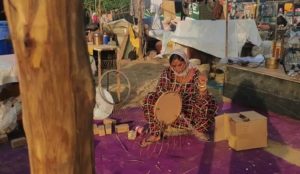
For Reena, this market, this land is the only ‘home’ she has known. “This place is not just our workplace, but also the place we identify with. If the government and the committee don’t let us live here and ask us to go somewhere else, I wouldn’t know where to go and if that place would feel the same.”
In search of fresh starts
Tired of the constant demolitions and uprooting, the sellers are willing to relocate to a new place and start everything fresh as they feel there’s no other option left. Anita confides, “We are not expecting much and we will go wherever the government sets us up. Irrespective of wherever the government chooses to keep us or relocate us, all we want is some stability and a permanent place to call home.”
Sahiba too is hoping for the government to help them settle down and to provide them with a place from where they won’t be evicted again. She says, “If the government wants us to go somewhere else, they should relocate us to a better place and all of us will accept it and join our hands together to collectively restart the market.”
The sellers don’t want or expect much, but just some reassurance, love and support. “We just want that we get a space to live and earn and that our kids get their right to be educated, irrespective of whether it’s at Banjara Market or wherever we go next. We are just looking for a space to live and earn, that’s it,” Reena concludes.
(Cover: Police personnel seen at the site amid a demolition drive by the Haryana Urban Development Authority (HUDA) at Banjara Market, on October 5, 2021 Photo: Getty Images)





